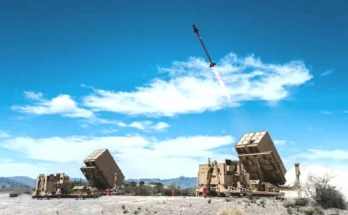
The U.S. State Department reported that FY2023 U.S. military exports rose to a record $238 billion, up almost 16 percent from $206 billion in FY2022.
The major driver in this jump is the war in Ukraine. Countries that sent weapons to support Kyiv are now desperately restocking their own shelves. The conflict served as a stark reminder of potential vulnerabilities, sending nations scrambling for the latest tech and firepower. The rise is a windfall for defense giants like Lockheed Martin, Boeing, RTX, and Northrop Grumman and is a potent tool in U.S. foreign policy, according to the department.
The trend is expected to continue in FY2024 as continued unrest in regions like Ukraine, the Middle East, and Asia will likely incentivize countries to boost military spending and replenish stocks, potentially favoring U.S. defense exports.
The $238 billion export total is composed of two components, $80.9 billion in Foreign Military Sales (government-to-government transfers of systems and services) and $157.5 billion in Direct Commercial Sales (sales to governments from U.S. contractors).
Foreign Military Sales:
In FY2023 the total value of transferred defense articles and services and security cooperation activities conducted under the Foreign Military Sales system was $80.9 billion. This represents a 55.9% increase, up from $51.9 billion in FY2022. This is the highest annual total of sales and assistance provided to our allies and partners.
The $80.9 billion figure for FY2023 includes $62.25 billion in arms sales funded by U.S. ally and partner nations; $3.97 billion funded through the Title 22 Foreign Military Financing program; and $14.68 billion funded through other Department of State programs (such as International Narcotics Control and Law Enforcement, Nonproliferation, Anti-terrorism, Demining, and Related Programs) and Department of Defense Building Partner Capacity programs (like the Ukraine Security Assistance Initiative).
The three-year rolling average value for transferred defense articles and services and security cooperation activities conducted under the Foreign Military Sales system was for FY2021-FY2023 was $55.9 billion. This represents a 21.9% increase from $45.8 billion for FY2020-FY2022.
| FY2022 | FY2023 | % Change | |
| FMS — Total Value | $51.9B | $80.9B | +55.9% |
| FY20-22 | FY21-23 | % Change | |
| FMS — Three-Year Rolling Average | $45.8B | $55.9B | +21.9% |
Examples of government-to-government FMS sales notified to Congress in FY2023 include:
- Poland – Apache Helicopters $12 billion,
- Poland – High Mobility Artillery Rocket System (HIMARS) $10 billion,
- Germany – CH-47F Chinook Helicopters $8.5 billion,
- Australia – C-130J-30 Aircraft $6.35 billion,
- Canada – P-8A Aircraft $5.9 billion,
- Czech Republic – F-35 Aircraft And Munitions $5.62 billion,
- Republic of Korea – F-35 Aircraft $5.06 billion,
- Poland – Integrated Air And Missile Defense (IAMD) Battle Command System (IBCS) $4.0 billion,
- Poland – M1A1 Abrams Main Battle Tanks $3.75 billion,
- Kuwait – National Advanced Surface-To-Air Missile System (NASAMS) Medium Range Air Defense System (MRADS) $3 billion,
- Germany – AIM-120C-8 Advanced Medium-Range Air-To-Air Missiles (AMRAAM) $2.90 billion,
- Kuwait – Follow-On Technical Support $1.8 billion,
- Bulgaria – Stryker Vehicles $1.5 billion, Republic of Korea – CH-47F Chinook Helicopters $1.5 billion,
- Japan – E-2D Advanced Hawkeye (AHE) Airborne Early Warning And Control (AEW&C) Aircraft $1.381 billion,
- Norway – Defense Articles And Services Related to the MH-60R Multi-Mission Helicopters $1.0 billion,
- Qatar – Fixed Site-Low, Slow, Small Unmanned Aircraft System Integrated Defeat System (FS-LIDS) $1.0 billion.
Direct Commercial Sales:
The total authorized value for privately contracted Direct Commercial Sales (DCS) authorizations for FY2023 was $157.5 billion, which includes the value of hardware, services, and technical data authorized from exports, temporary imports, reexports, retransfers, and brokering. This represents a 2.5% increase, up from $153.6 billion in FY2022.
The three-year rolling average of DCS authorizations issued by the State Department for FY2021-FY2023 was $124.9 billion, which was a 2.5% increase over the period FY2020-FY2022.
| FY2022 | FY2023 | % Change | |
| DCS — Total Value | $153.6B | $157.5B | +2.5% |
| Total Licenses Adjudicated | 22,138 | 23,474 | +6.0% |
| Total Licensed Entities | 14,861 | 14,445 | +2.9% |
| FY20-22 | FY21-23 | % Change | |
| DCS — Three-Year Rolling Average | $107.2B | $124.9B | +16.5% |
Examples of major DCS Congressional Notifications (CNs) in FY2023 include:
- Italy – For the manufacturing of F-35 wing assemblies and sub-assemblies ($2.8 billion)
- India – For the manufacturing of GE F414-INS6 Engine hardware ($1.8 billion)
- Singapore – F100 propulsion system and spare parts to the Republic of Singapore, and the Ministry of Defense ($1.2 billion)
- South Korea – F100 propulsion system and spare parts to the Republic of Korea Ministry of National Defense ($1.2 billion)
- Norway, Ukraine – National Advanced Surface to Air Missile System (NASAMS), Norwegian Ministry of Defence, and Ukraine Ministry of Defence ($1.2 billion)
- Kingdom of Saudi Arabia – Patriot Guided Missile – Tactical, Royal Saudi Air Defense Forces ($1 billion)
A military history enthusiast, Richard began at Forecast International as editor of the World Weapons Weekly newsletter. As the Internet grew in importance as a research tool, he helped design the company's Forecast Intelligence Center and currently coordinates the EMarket Alert newsletters for clients. Richard also manages social media efforts, including two new blogs: Defense & Security Monitor, covering defense systems and international issues, and Flight Plan, which focuses on commercial aviation and space systems. For over 30 years, Richard has authored the Defense & Aerospace Companies, Volume I (North America) and Volume II (International) services. The two books provide detailed data on major aerospace and defense contractors. He also edits the International Contractors service, a database that tracks all the contractors involved in the programs covered in the FI library. More recently he was appointed Manager, Information Services Group (ISG), a new unit that encompasses developing outbound content for both Forecast International and Military Periscope.



